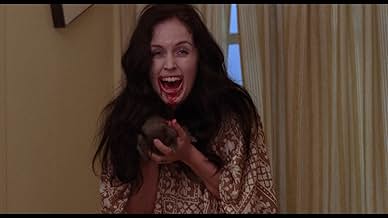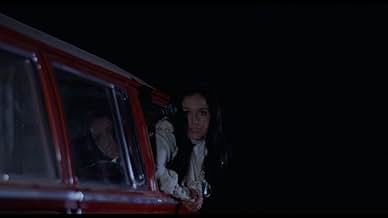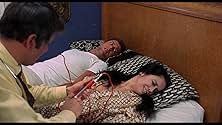AVALIAÇÃO DA IMDb
5,7/10
3,3 mil
SUA AVALIAÇÃO
Um casal convida um conde da Hungria para realizar uma sessão, sem saber que ele é um vampiro.Um casal convida um conde da Hungria para realizar uma sessão, sem saber que ele é um vampiro.Um casal convida um conde da Hungria para realizar uma sessão, sem saber que ele é um vampiro.
- Direção
- Roteirista
- Artistas
Donna Anderson
- Donna
- (as Donna Anders)
Judy Lang
- Erica Landers
- (as Judith Lang)
George Macready
- Narration
- (narração)
Erica Macready
- Babette - the nurse
- (não creditado)
Mark Tapscott
- Peter (seance guest)
- (não creditado)
Stella Thomas
- Vampire Woman
- (não creditado)
Avaliações em destaque
When we think of great vampire portrayals, normally the names of Lugosi and Christopher Lee immediately pop into our heads. Robert Quarry, however, is as convincing a vampire as both of those great actors. His performance and demeanor as a Bulgarian Count in this film is truly outstanding. He lives in a large house somewhere in California and terrorizes young women and their boyfriends. What makes this picture a better than average vampire film is that it has a very tense and atmospheric plot structure. We basically know what fate will befall our innocent(just) protagonists, but we become riveted to their actions and those of the Count. Quarry plays the Count with a charm that is both amiable and yet caustic. He makes one of the wittiest vampires in film. The rest of the cast is adequate, and I think Roger Perry does a wonderful job as a blood specialist who goads Count Yorga one evening into talking about the supernatural. A must see for the classic horror fan.
Count Yorga (1970) was one of my childhood favorites. Like most of the films that I saw when I was younger I watched it on a small black and white T.V. My dad was also a fan of this one as well. It was one of the first movies I saw on videotape. This movie is a culture clash flick. An old school vampire living in the early seventies. The Count comes to California and starts up a harem of sexy vampires. Their angry boyfriends decide to team up together to try and put an end to the Count's midnight snacks. Total 70's action her folks. Count Yorga is one who's not to be trifled with. So grab some garlic and a crucifix 'cause Count Yorga might be in your neighborhood. Robert Quarry is the man as Count Yorga, and what's up with the coffin movers? Time capsule material.
Recommended
Recommended
Not owning the rights to the Bram Stoker creation, AIP decided to invent their own vampire myth: the result is Dracula-in-all-but-name, being suave (sporting gracefully graying hair), cunning (even when caught off-guard, he manages to assert himself and turn the tables on interlopers), psychic (amusingly, he doubles as a medium at private séances!) and feral (his creepy dashes for prospective victims, seemingly out of nowhere, with blood-red eyes and arms outstretched actually gave me a jolt on a couple of occasions!). As played by Robert Quarry, he is quite creditable and effectively gave Christopher Lee (Hammer Film's Dracula incarnate) a run for his money.
Incidentally, he anticipated the other Count's transition to modern times by 2 years and actually managed it a whole lot better (with, thankfully, little resort to Camp). That said, in the attempt to look at the phenomenon with a contemporary mindset, we get a contradiction – people repeatedly scoff at the idea of vampirism in our age, claiming it is a fabrication of literature and cinema, which rather suggests that they are aware of what it entails and, yet, they are still surprised at what should be its predictable outcome and are required besides to pore over ancient tomes in search of a way to fight it! Though the film was given the alternate title of THE LOVES OF COUNT IORGA, VAMPIRE {sic}, which is actually borne by the copy I watched (for the record, this had been shown on local TV in my childhood but I first caught it years later on British Cable TV), it does not overstress the romantic angle. Indeed, one girl is shown quenching her unnatural thirst for blood by literally draining the life out of a kitten! The presence of a sinister (that is to say, hulking and deformed) acolyte is, admittedly, a bit of a cliché – but Yorga himself seems to have moved with the times (in spite of his traditional attire), since he is shown jadedly presiding over a lesbian vampire show in his living-room!
The stylish film was produced by Michael Macready (who also assumes the requisite heroic persona on-screen, though the doctor-turned-vampire-hunter played by Roger Perry actually has an even more central role!), son of distinguished character actor George Macready (who generously supplies the portentous narration here and which, at the start, erroneously refers to vampires as "The Living Dead"{!}: indeed, the whole film – scripted by Kelljan himself – aspires to a certain literariness but often merely results in being verbose which, however, it often works around by having characters conversing about the unusual events in which they had been thrust presented as voice-over laid on exterior crowd scenes!). The climax is a downbeat one: while Yorga is almost comically disposed of by being pierced (typically, through the heart) with a splintered broomstick, the lone-survivor hero sustains a vampiric attack from his own girlfriend (herself newly-inducted into the ranks of the Undead)! AIP presumably turned a fast profit with this one, seeing how they immediately commissioned a sequel (and whose own viewing followed that of the original in the current "Halloween Challenge"). However, they would soon come up with yet another (and even more outrageous) variation on vampire lore with the cult Blaxploitation offering BLACULA (1972) – which, in turn, led to the as-yet-unwatched SCREAM BLACULA SCREAM! (1973; helmed by Kelljan himself!)...
Incidentally, he anticipated the other Count's transition to modern times by 2 years and actually managed it a whole lot better (with, thankfully, little resort to Camp). That said, in the attempt to look at the phenomenon with a contemporary mindset, we get a contradiction – people repeatedly scoff at the idea of vampirism in our age, claiming it is a fabrication of literature and cinema, which rather suggests that they are aware of what it entails and, yet, they are still surprised at what should be its predictable outcome and are required besides to pore over ancient tomes in search of a way to fight it! Though the film was given the alternate title of THE LOVES OF COUNT IORGA, VAMPIRE {sic}, which is actually borne by the copy I watched (for the record, this had been shown on local TV in my childhood but I first caught it years later on British Cable TV), it does not overstress the romantic angle. Indeed, one girl is shown quenching her unnatural thirst for blood by literally draining the life out of a kitten! The presence of a sinister (that is to say, hulking and deformed) acolyte is, admittedly, a bit of a cliché – but Yorga himself seems to have moved with the times (in spite of his traditional attire), since he is shown jadedly presiding over a lesbian vampire show in his living-room!
The stylish film was produced by Michael Macready (who also assumes the requisite heroic persona on-screen, though the doctor-turned-vampire-hunter played by Roger Perry actually has an even more central role!), son of distinguished character actor George Macready (who generously supplies the portentous narration here and which, at the start, erroneously refers to vampires as "The Living Dead"{!}: indeed, the whole film – scripted by Kelljan himself – aspires to a certain literariness but often merely results in being verbose which, however, it often works around by having characters conversing about the unusual events in which they had been thrust presented as voice-over laid on exterior crowd scenes!). The climax is a downbeat one: while Yorga is almost comically disposed of by being pierced (typically, through the heart) with a splintered broomstick, the lone-survivor hero sustains a vampiric attack from his own girlfriend (herself newly-inducted into the ranks of the Undead)! AIP presumably turned a fast profit with this one, seeing how they immediately commissioned a sequel (and whose own viewing followed that of the original in the current "Halloween Challenge"). However, they would soon come up with yet another (and even more outrageous) variation on vampire lore with the cult Blaxploitation offering BLACULA (1972) – which, in turn, led to the as-yet-unwatched SCREAM BLACULA SCREAM! (1973; helmed by Kelljan himself!)...
At the time this film was made, vampires were almost always slow and hypnotic. This was really the first vampire film that treated them as swift and animalistic. That made this film surprisingly effective. It was even more surprising since it was originally supposed to be a pornographic vampire film called THE LOVES OF COUNT IORGA. It is flawed, but I still think it is the most effective vampire film I have ever seen. And I have seen quite a few.
I was a bit surprised by this rather low budget 1970s incarnation of vampire films. That's because around this same time period, vampire films were getting a bit stale and silly--with too many Hammer Dracula films (the franchise was getting weaker due to so many sequels) as well as dumb films like OLD Dracula and the Blacula films (which weren't terrible, but they sure were silly). However, despite my fear that this would be another stale film, this one turned out to be better than average and well worth a look. While only a nut would compare this to the greatness of Dracula or NOSFERATU, it still is a decent example of the franchise.
Before talking about the plot, there was something odd I noticed and that was how sexy the film was and it looked, at times, like it was a soft-core porno movie. However, again and again when it looked like it was going that direction, the movie abruptly changed direction--sometimes as if scenes were edited out to make this a film for general viewing. I checked IMDb for this and was not at all surprised to find that this was indeed the case. For example, a lesbian sex scene seemed about to occur--then the scene just ended. In another case, a woman was wearing a very revealing nightgown and began a very torrid scene with Iorga (there were two spellings in the film) and this just ended as well. There was also a very gratuitous scene involving a couple making love in a van for absolutely no reason--but again, with creative editing you really didn't see anything! As a result, the film is still quite sexy--but also one you could probably still let your teens watch.
Iorga/Yorga lives in the Los Angeles area in a house that looks more like a castle than a house. Even in crazy L.A., this house was definitely out of place! The film begins with his having a séance with three couples and it's soon apparent that the Count has magical hypnotic powers. Soon, it also becomes rather obvious that the Count is a heterosexual vampire--with strong desires for the three women but only a desire to kill off the men.
Many elements are taken from Dracula--even including a Dr. Helsing-like character. Despite the familiarity, the decent acting and nice update of the old tale make this worth a look. Plus the performance by the guy playing the Count was pretty cool.
Before talking about the plot, there was something odd I noticed and that was how sexy the film was and it looked, at times, like it was a soft-core porno movie. However, again and again when it looked like it was going that direction, the movie abruptly changed direction--sometimes as if scenes were edited out to make this a film for general viewing. I checked IMDb for this and was not at all surprised to find that this was indeed the case. For example, a lesbian sex scene seemed about to occur--then the scene just ended. In another case, a woman was wearing a very revealing nightgown and began a very torrid scene with Iorga (there were two spellings in the film) and this just ended as well. There was also a very gratuitous scene involving a couple making love in a van for absolutely no reason--but again, with creative editing you really didn't see anything! As a result, the film is still quite sexy--but also one you could probably still let your teens watch.
Iorga/Yorga lives in the Los Angeles area in a house that looks more like a castle than a house. Even in crazy L.A., this house was definitely out of place! The film begins with his having a séance with three couples and it's soon apparent that the Count has magical hypnotic powers. Soon, it also becomes rather obvious that the Count is a heterosexual vampire--with strong desires for the three women but only a desire to kill off the men.
Many elements are taken from Dracula--even including a Dr. Helsing-like character. Despite the familiarity, the decent acting and nice update of the old tale make this worth a look. Plus the performance by the guy playing the Count was pretty cool.
Você sabia?
- CuriosidadesThis film was originally conceived as a low budget softcore pornography film titled "The Loves of Count Iorga, Vampire". Later, however, the decision was made to film it as a regular horror film with the less erotic title "Count Yorga, Vampire" . This name change explains the poor animation of the name "Count Yorga" in the film's title as it now appears on-screen. The original title and original Iorga spelling were both restored to the film by the 1990s, but all prints of it were still identical to the original 1970 release. Apparently, no additional footage survives from its original porn version of it at all and it is unknown if said version was actually filmed or, if it was filmed, whether or not it was finished or even released if it was (it is worth noting, however, that the characters often pronounce the Count's name within the film as "Iorga" (ee-yor-ga) and not as "Yorga" (yor-ga)).
- Erros de gravaçãoCount Yorga's fangs are inconsistent throughout the entire film: sometimes all of his visible teeth are pointed, but in a few shots only his canines are pointed while his incisors are not.
- Citações
Count Yorga: Doctor Hayes, what an unexpected surprise.
Dr. James Hayes: Yes, so much so that I almost had a massive coronary.
- Versões alternativasThe new Twilight Time DVD version of the film contains a longer version of the kitten eating scene.
- ConexõesEdited into Blacula, O Vampiro Negro (1972)
Principais escolhas
Faça login para avaliar e ver a lista de recomendações personalizadas
- How long is Count Yorga, Vampire?Fornecido pela Alexa
- Who are the other vampire girls besides Erica?
- Why does Yorga target and turn Erica into a vampire?
- Why does Paul not stake Erica when given the chance and why does Erica pause after attacking him?
Detalhes
Bilheteria
- Orçamento
- US$ 64.000 (estimativa)
Contribua para esta página
Sugerir uma alteração ou adicionar conteúdo ausente

Principal brecha
By what name was Conde Yorga, Vampiro (1970) officially released in India in English?
Responda

























